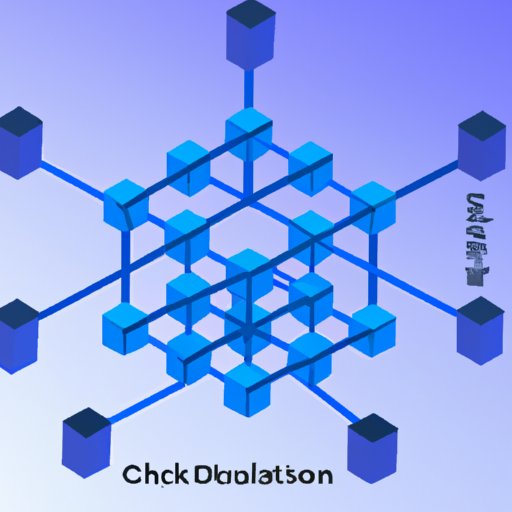Introduction
As the world continues to move more towards digitalization, new technologies are being developed that have the potential to revolutionize the way we do business. One such technology is blockchain, which has become increasingly popular in recent years due to its potential to create a secure and transparent system for exchanging data.
But what is blockchain exactly? In this article, we’ll explore what blockchain is, how it works, and why it has become so important in today’s digital world.
An Overview of Blockchain Technology: What Is It and How Does It Work?
At its core, blockchain is a distributed ledger technology that enables the secure and transparent exchange of data without the need for intermediaries. It is a decentralized, immutable, and incorruptible digital ledger that records transactions between two or more parties in an efficient and verifiable manner.
In order for a transaction to be added to the blockchain, it must be validated by all participants in the network. This process is known as consensus, and it ensures that all parties involved in the transaction agree on the validity of the data. Once a transaction is verified, it is added to the blockchain as a “block” and cannot be altered or deleted.
There are different types of blockchains, each with their own distinct features. The most popular type of blockchain is the public blockchain, which is open to anyone who wishes to join. There are also private and hybrid blockchains, which provide more control over who can access the network and the data stored within it.
Exploring the Basics of Blockchain: A Beginner’s Guide
Blockchain technology offers a number of benefits to businesses, including increased security, transparency, and efficiency. By eliminating the need for intermediaries, blockchain technology can reduce costs and speed up the process of exchanging data. It also provides users with a secure platform for storing data, as it is virtually impossible to tamper with or alter information once it has been added to the blockchain.
Common use cases for blockchain technology include payments, supply chain management, identity management, and healthcare. As the technology continues to evolve, more use cases are likely to emerge.
Despite its many benefits, there are still some challenges facing blockchain technology. These include scalability issues, as blockchains can only handle a limited amount of transactions at any given time. Additionally, there is still a lack of regulation and standardization, which can make it difficult for businesses to comply with the law.
Breaking Down the Complexity of Blockchain: A Layman’s Guide
To fully understand blockchain technology, it’s important to understand some of the key concepts that underpin it. These include cryptography, smart contracts, and cryptocurrencies.
Cryptography is a branch of mathematics that deals with encrypting and decrypting data. It is used to secure data stored in the blockchain and ensure that only authorized users can access it. Smart contracts are self-executing contracts that are stored on the blockchain. They are designed to automatically execute certain actions when predetermined conditions are met. Finally, cryptocurrencies are digital currencies that are built on top of blockchain technology.

The ABCs of Blockchain: Explaining Blockchain in Easy Terms
When it comes to understanding blockchain technology, it’s important to understand the three main principles that underpin it: decentralization, immutability, and consensus algorithms.
Decentralization refers to the fact that there is no single entity that controls the blockchain. Instead, it is managed by a network of computers that are spread across the globe. This makes it much harder for hackers to gain access to the data stored on the blockchain.
Immutability means that once a transaction is added to the blockchain, it cannot be changed or deleted. This ensures that all data stored on the blockchain is accurate and secure. Finally, consensus algorithms are used to verify transactions on the blockchain. This ensures that all participants in the network agree on the validity of the data before it is added to the blockchain.
Understanding Blockchain: A Comprehensive Guide for the Average Joe
In addition to the three core principles of blockchain technology, there are also other aspects to consider, such as security, privacy, and scalability. Security is critical when it comes to blockchain technology, as hackers may try to gain access to the data stored on the blockchain. To protect against this, blockchains use advanced cryptography and other methods to ensure that only authorized users can access the data.
Privacy is another important aspect of blockchain technology. Blockchains offer users a high degree of privacy, as data stored on the blockchain is encrypted and only accessible to those with permission. Finally, scalability is an issue that must be addressed when using blockchain technology. Currently, blockchains can only handle a limited amount of transactions at any given time, but this is something that developers are working to improve.
Conclusion
In conclusion, blockchain technology has the potential to revolutionize the way we exchange data. It is a secure and transparent form of data storage that eliminates the need for intermediaries and allows for secure and accurate transactions. From understanding cryptography to exploring the basics of blockchain, this article has provided a comprehensive guide to understanding blockchain technology.
By understanding the principles of decentralization, immutability, and consensus algorithms, as well as the importance of security, privacy, and scalability, you can begin to appreciate the power of blockchain technology and how it can benefit both businesses and individuals.
(Note: Is this article not meeting your expectations? Do you have knowledge or insights to share? Unlock new opportunities and expand your reach by joining our authors team. Click Registration to join us and share your expertise with our readers.)
